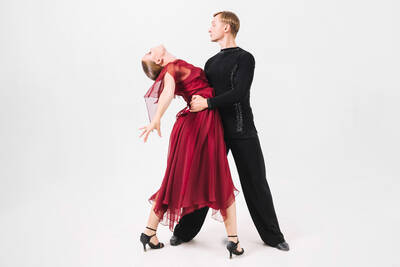Miaoli’s paddy fields, which were once used only for growing rice, have been transformed into canvases for expressing love. Yuanli Farmers Association has been promoting paddy art for the past nine years, and now that they have perfected the art, they are accepting requests for customized paddy “paintings.”
Liang Ruei-hsu, the head of Yuanli Farmers Association’s promotions department, said that most people are curious when they see the dark mauve color of Indica rice plants, so by using these plants along with green plants they can create paddy art and provide employment opportunities for farmers.
Liang says that the association has become very proficient at paddy art and can provide customized creations, whether they are signs, characters, pictures or letters.
In June, one man used paddy art to successfully propose to his girlfriend. Chang Chia-wei, an employee at a paper company, paid NT$30,000 to get the association to write the message “Yen Ju, Follow me OK.” When Liao Yen-ju, his fiancée, saw the rice paddy, she immediately accepted his proposal in front of a cheering crowd of friends.
Paddy art started in 1993, in a village called Inakadate in northern Japan. Although the village has a population of less than 8,500, its paddy art attracts 170,000 tourists per year and brings in a steady stream of income to the local economy. According to news reports, the management office makes NT$1.2 million dollars annually from rent, plan-ting and field maintenance, but visitor donations typically come in at around double that figure.
To create paddy art, the farmers first make a grid on the ground and then create an outline of the pictures or words they want to create, before finally planting the mauve rice plant seeds. Seeds can be planted twice a year, toward the end of February and July.(LIBERTY TIMES, TRANSLATED BY TAIJING WU)
苗栗以往只能種米的稻田,最近搖身一變成為示愛的畫布。苑裡鎮農會推動稻田彩繪邁入第九年,如今稻田彩繪技術成熟,還可接受「客製化」彩繪。
苑裡鎮農會推廣股長梁瑞旭說,一般人對在來米的紫色稻穗感到好奇,所以利用紫色及綠色兩種稻穗,創造稻田彩繪,提供農友就業機會。
梁瑞旭說,苑裡鎮農會的稻田彩繪技術已經純熟,不管是圖騰、文字或圖案、英文字母都可提供「客製化」服務。
六月份就有一位男子,借助彩繪稻田之力,成功地向女朋友求婚。在紙廠上班的張家瑋花了三萬元,委託農會在一幅彩繪稻田上寫著「Yen Ju, Follow me OK」(研如,跟著我好嗎),結果女主角廖研如看到字樣後,在朋友的歡呼下接受求婚。
事實上彩繪稻田藝術於一九九三年,在日本北部的田舍館村誕生。該村人口不到八千五百人,每年卻因此引來十七萬觀光客,各個爭先恐後的想一賭稻田上的圖案,也給當地帶來龐大商機。據報導,田舍館的稻田租金,種植與維護費用每年約台幣一百一十二萬元,但參觀民眾的捐款就多達台幣二百二十四萬元。
如要在稻田上畫出圖案,必須在稻田上以線條畫出格子,然後依照圖樣訂出座標,描出圖樣或字體的輪廓,再種下紫色秧苗。每年的二月底與七月底則為插秧期。
(自由時報記者張勳騰)

For many people in Taiwan, childhood memories of rural life include pig pens standing beside family homes. Leftover rice, vegetable scraps and soup from daily meals were poured into buckets and fed to pigs. This practice of feeding pigs with household food waste was once a common way of life, both an economic choice and an expression of agricultural society’s deep respect for conserving resources. From a practical standpoint, pigs are omnivorous animals capable of efficiently digesting food scraps that humans can no longer eat. For rural households, food waste cost almost nothing, yet it could be converted into pork, a

Tango unfolds in a dimly lit room, where a haunting melody ushers two dancers into a close embrace. Here, music and movement merge into a silent yet passionate conversation, expressing longing, memory and shared purpose. What makes tango truly magical is the deep interaction and spontaneous improvisation between partners. Tango began in the late 19th century in Buenos Aires, Argentina’s bustling capital. Born in the poor working-class neighborhoods and busy port areas, this dance emerged from a melting pot of cultures. European immigrants, African slaves and local residents all contributed to its unique character. From these rich influences, tango

A: What show are you watching online? B: I’m watching “Fly Me to the Moon & Back” – an exhibition launched by the Taipei Music Center (TMC) to commemorate the late singer Tom Chang. A: Known for his sky-high notes, Chang is praised as one of the best singers in the 1990s. His death at the age of 31 was a major loss indeed. B: And I’m so glad that we went to the TMC’s 90s-themed concert last Friday. I finally saw the iconic “Godmother of Rock” WaWa perform live. A: This year-end show also featured singers Princess Ai, Bii, Wayne Huang, PoLin and

Continued from yesterday(延續自昨日) https://www.taipeitimes.com/News/lang The loss of sea stars significantly impacts the ocean ecosystem. Sea stars are important __6__ that help control populations of mussels and sea urchins. Among them, the sunflower star is one of the largest and fastest sea stars and is adept at preying on sea urchins. Without sea stars, sea urchins can __7__ in numbers and devastate kelp forests. These forests are essential __8__ for many marine animals and also help capture carbon from the atmosphere, which is vital in the fight against climate change. The mystery behind SSWD is still __9__, but it is clear that